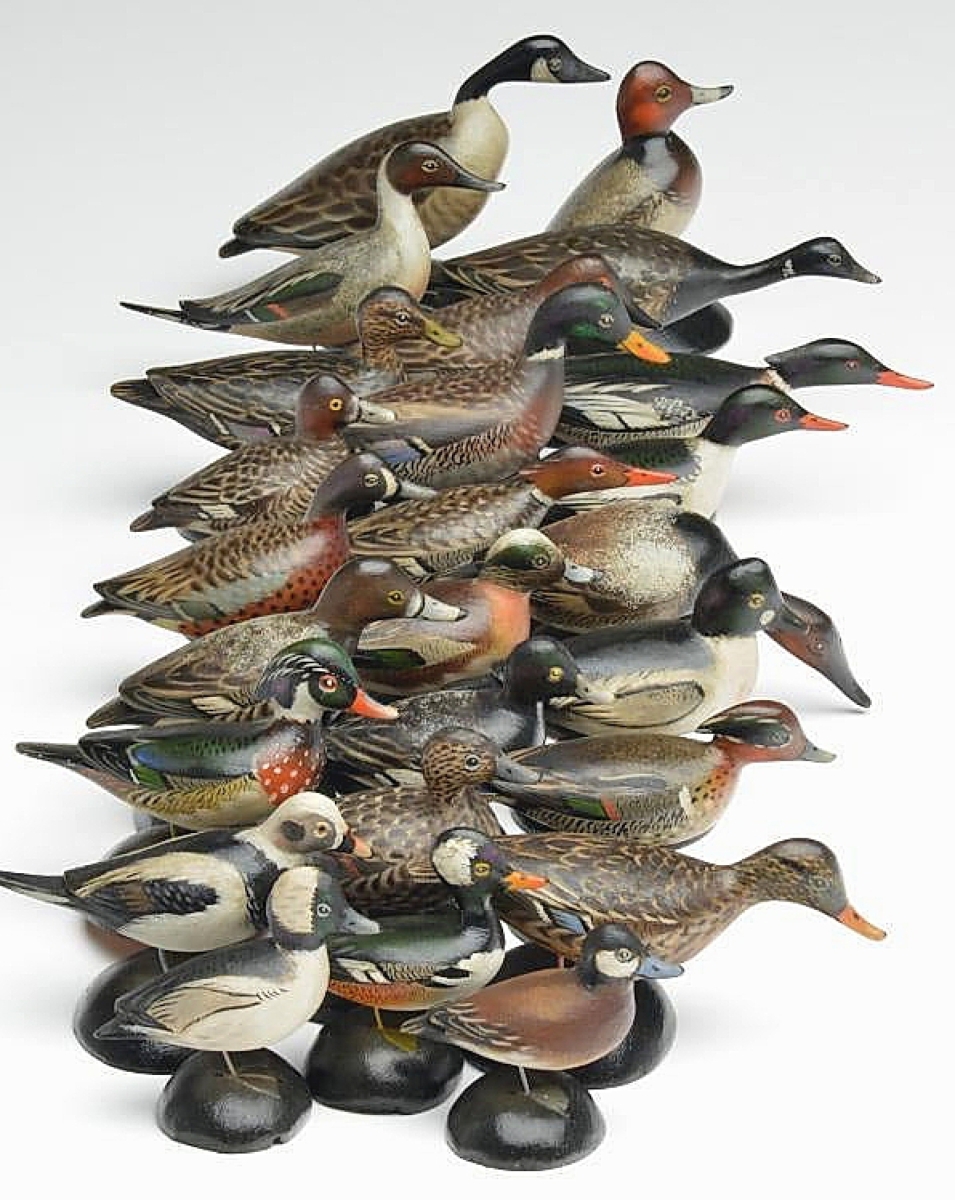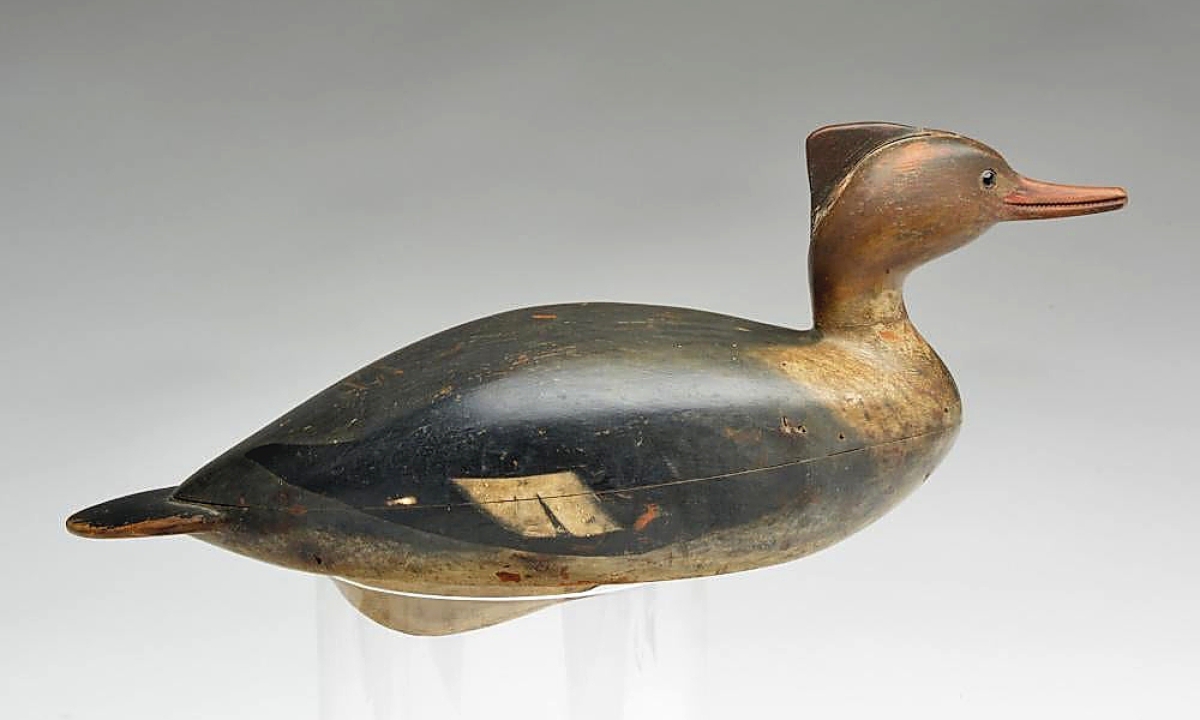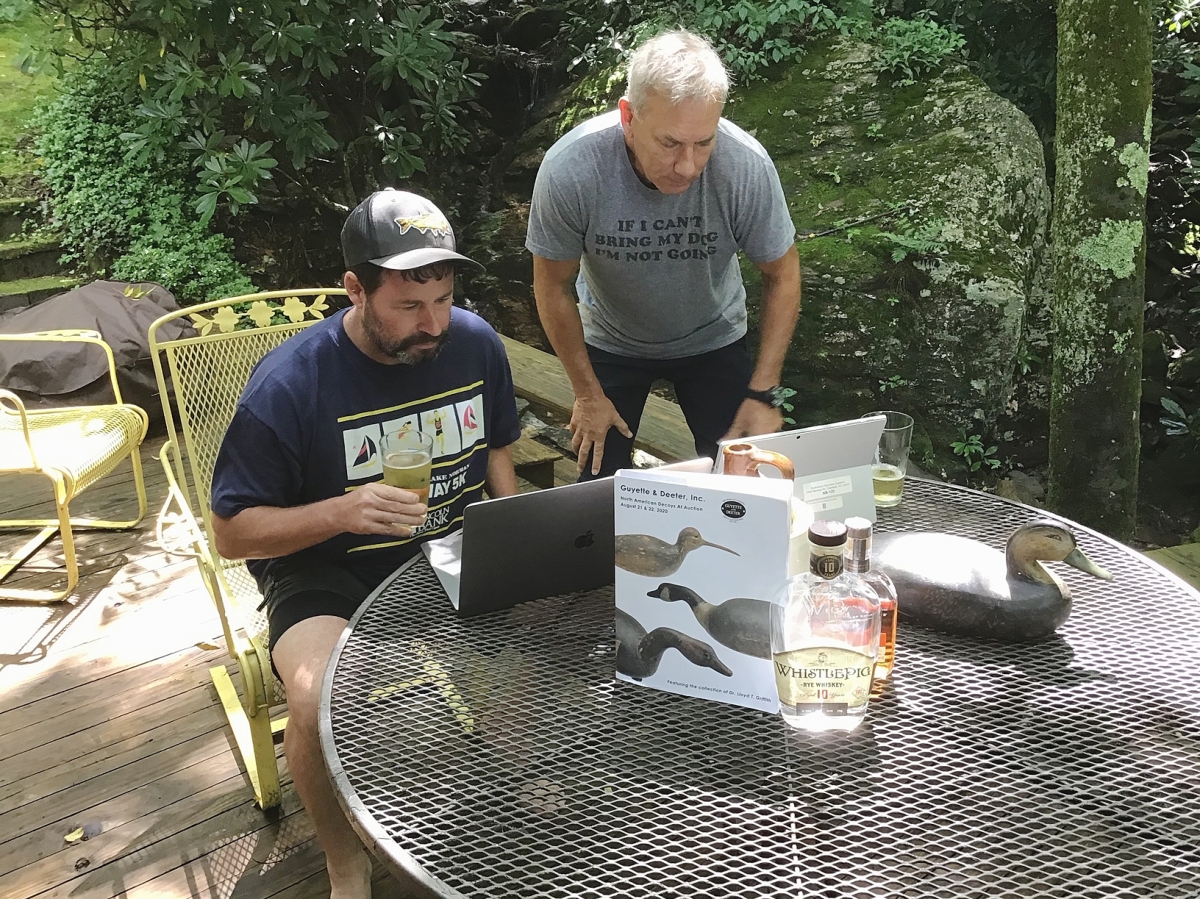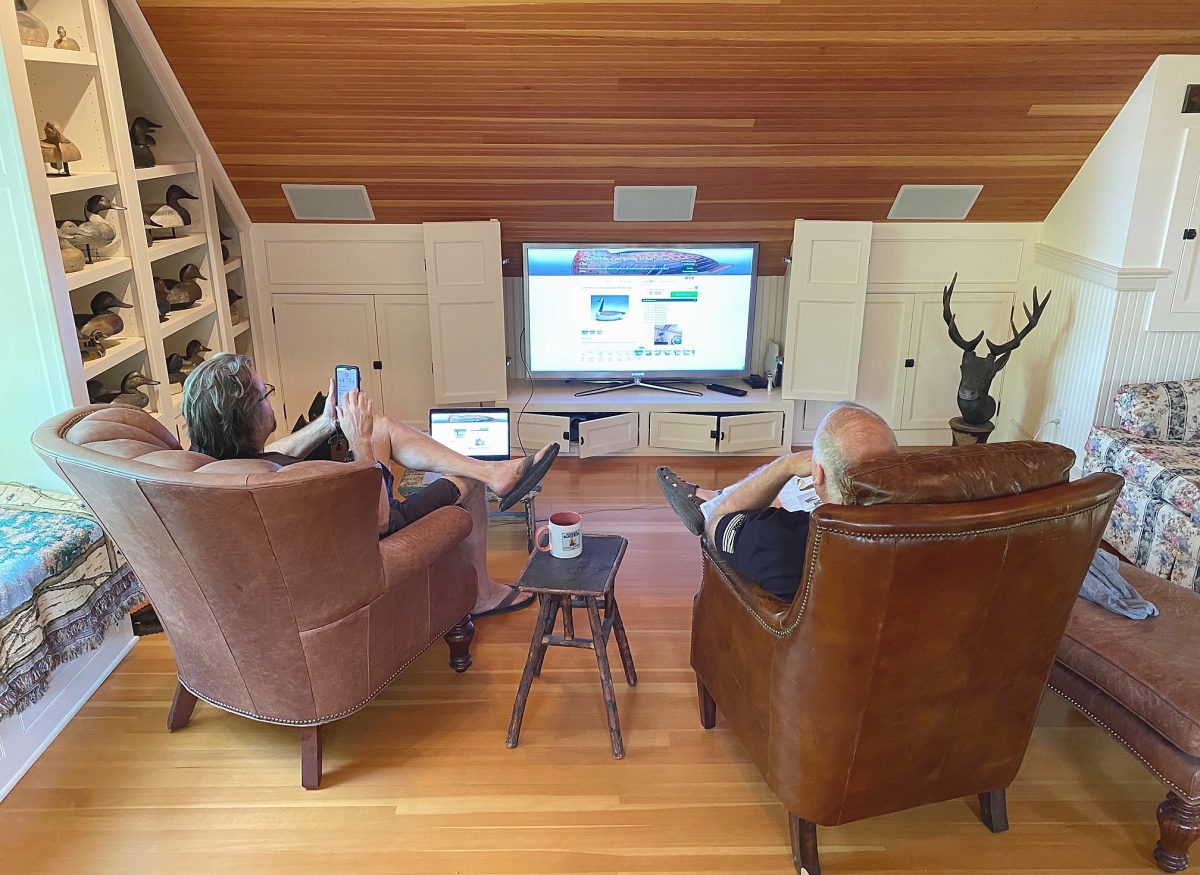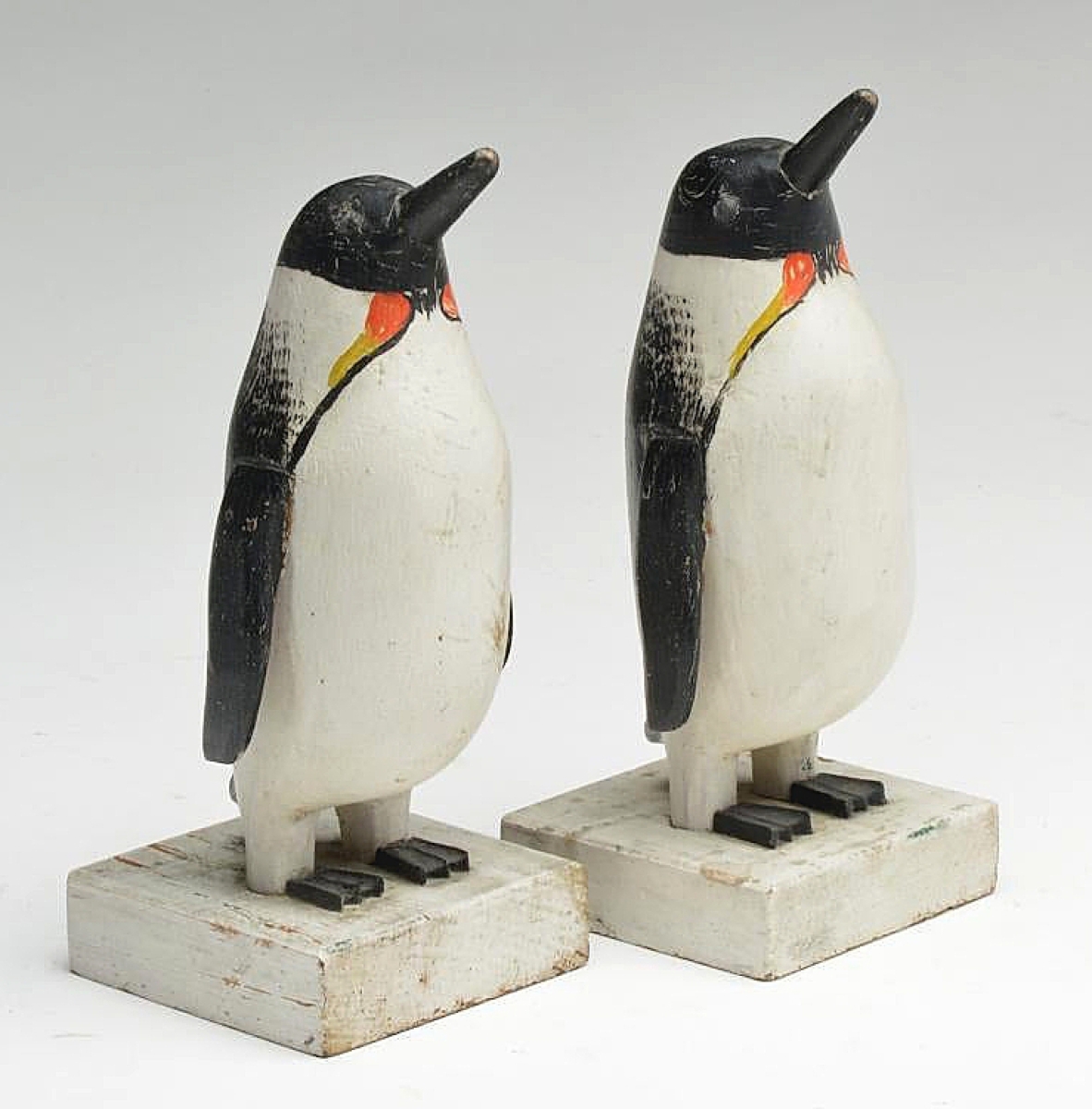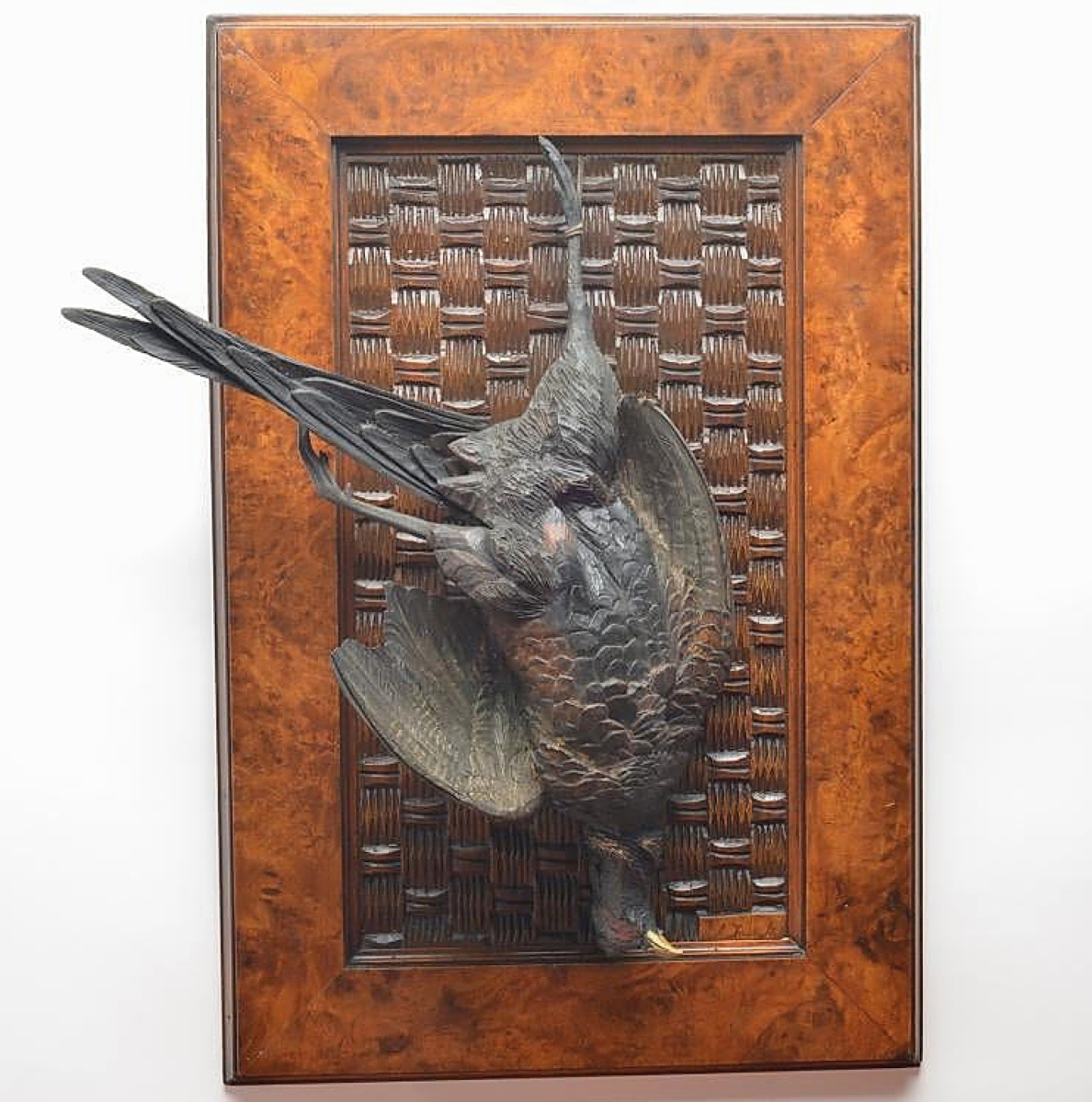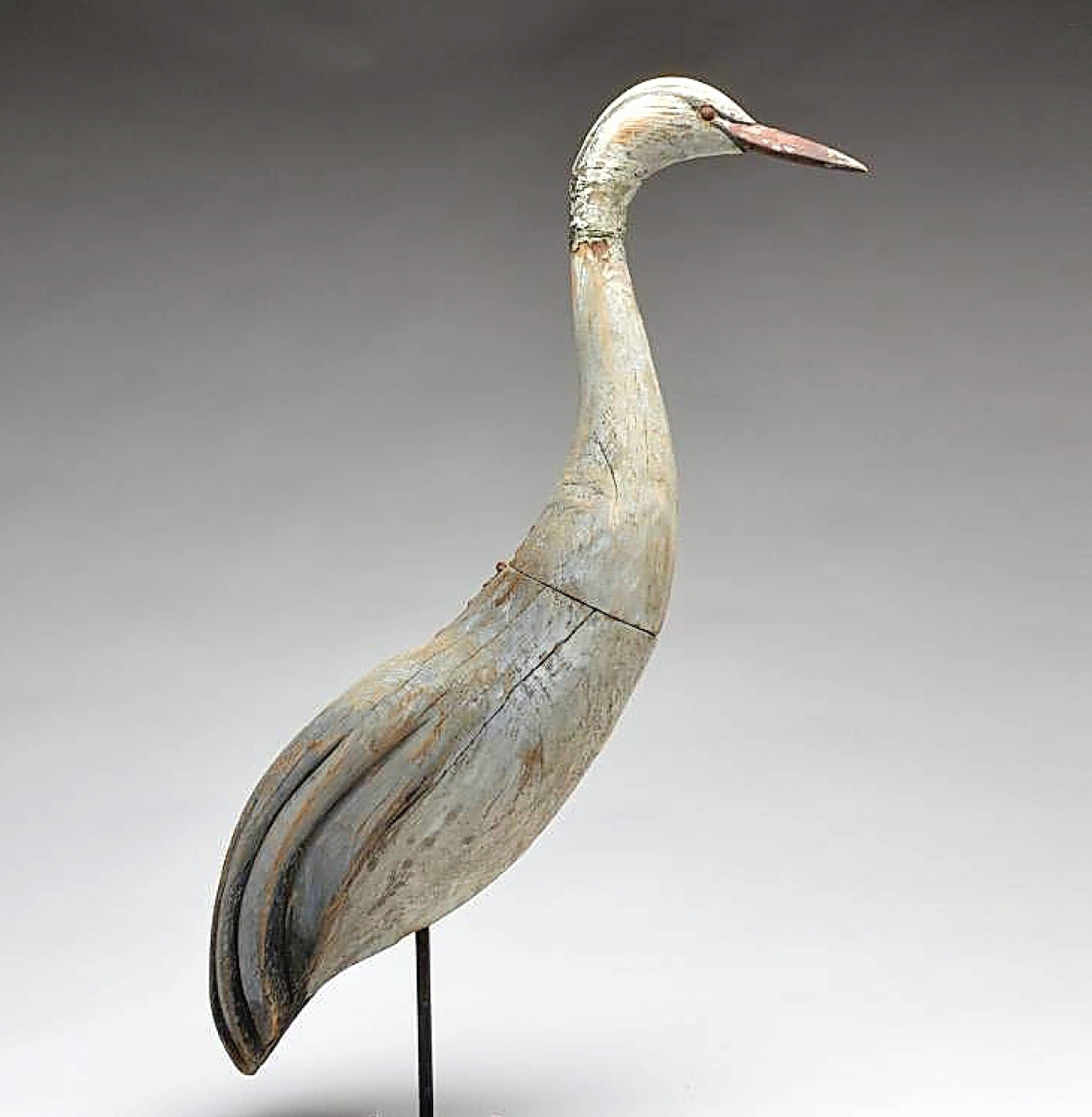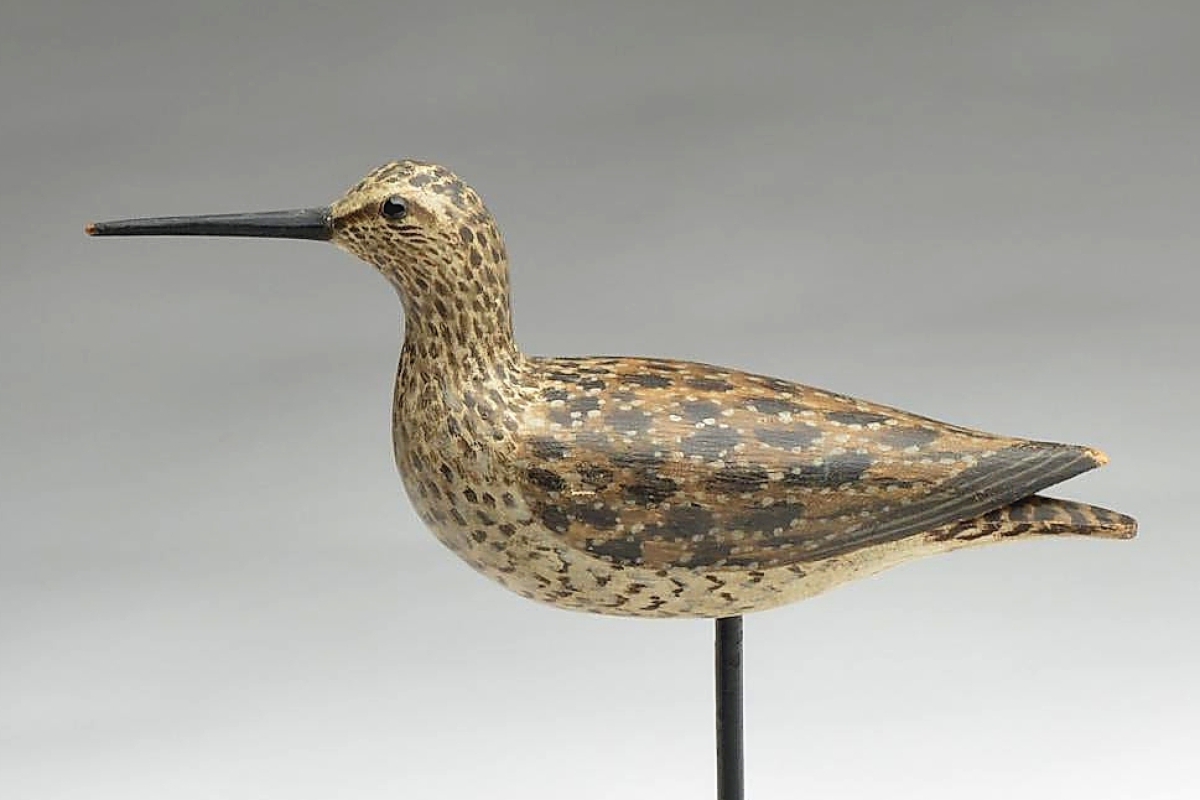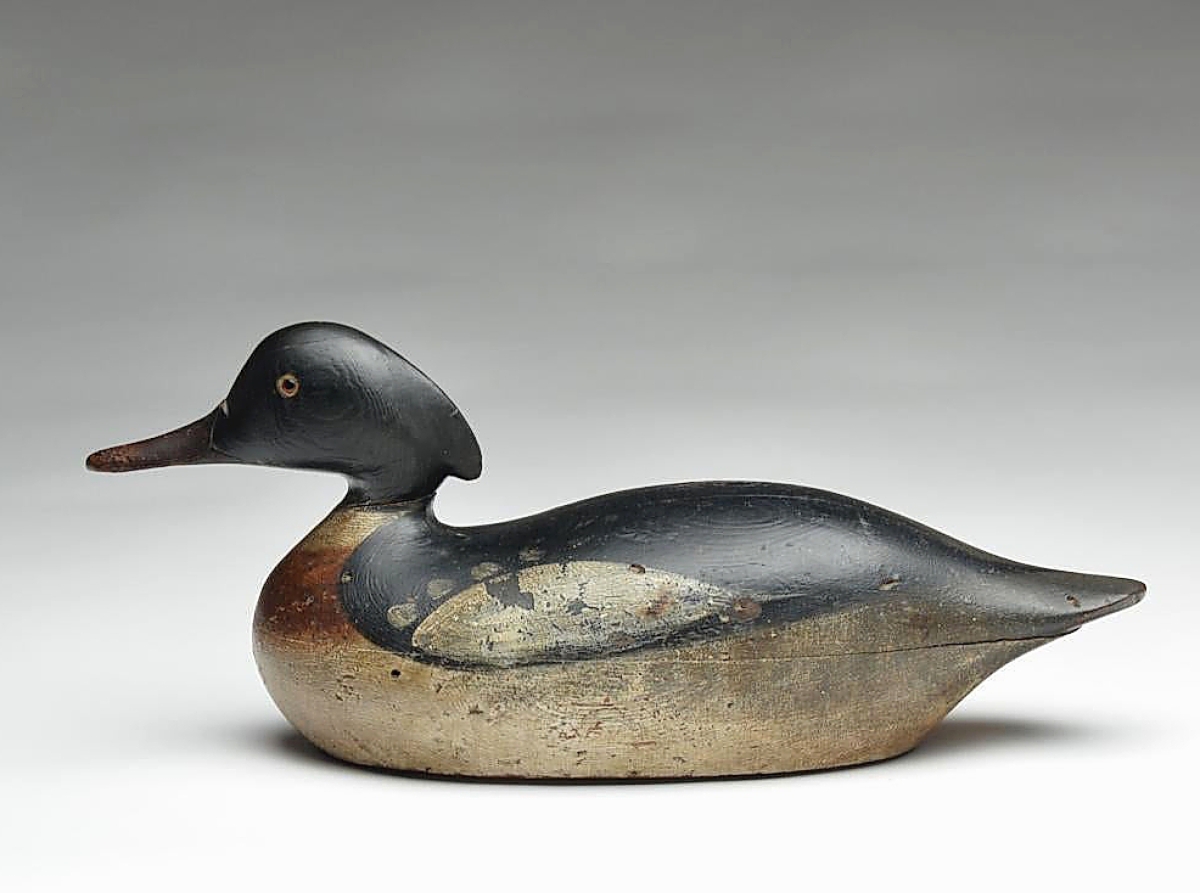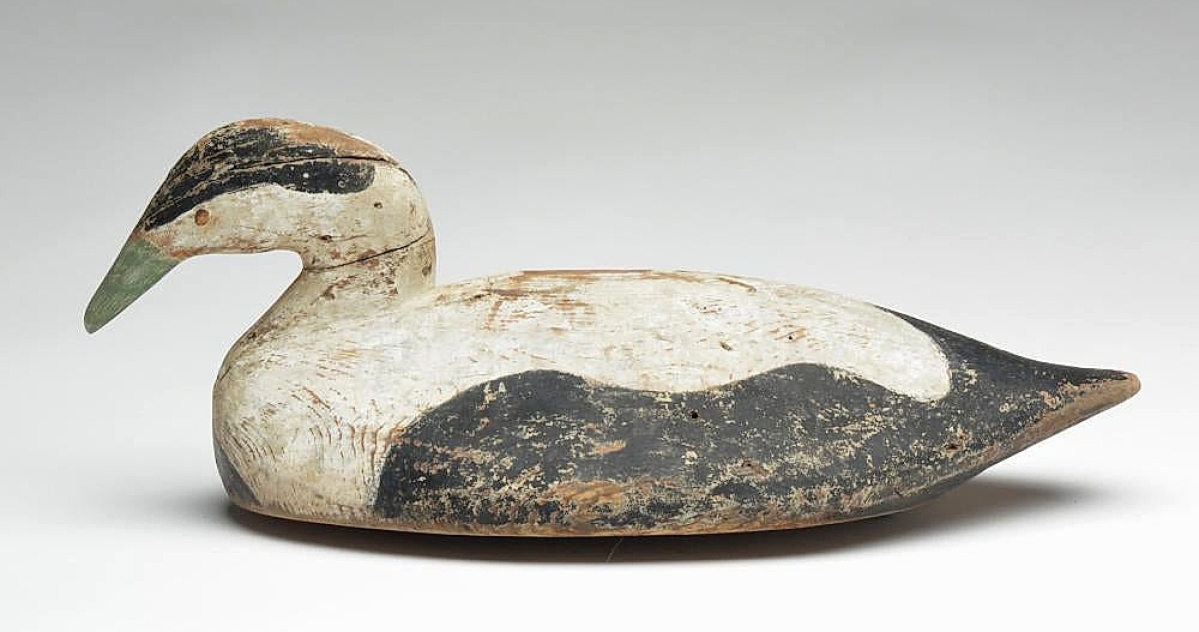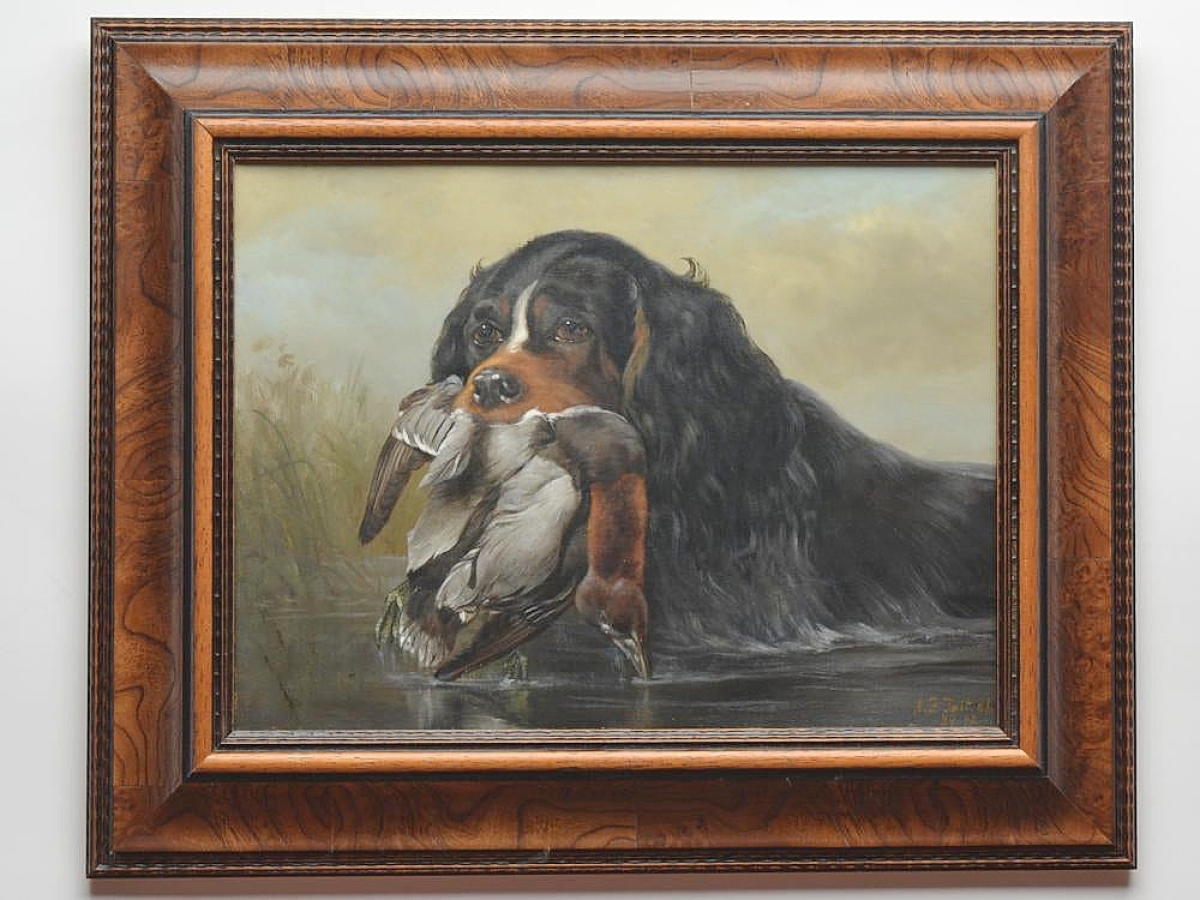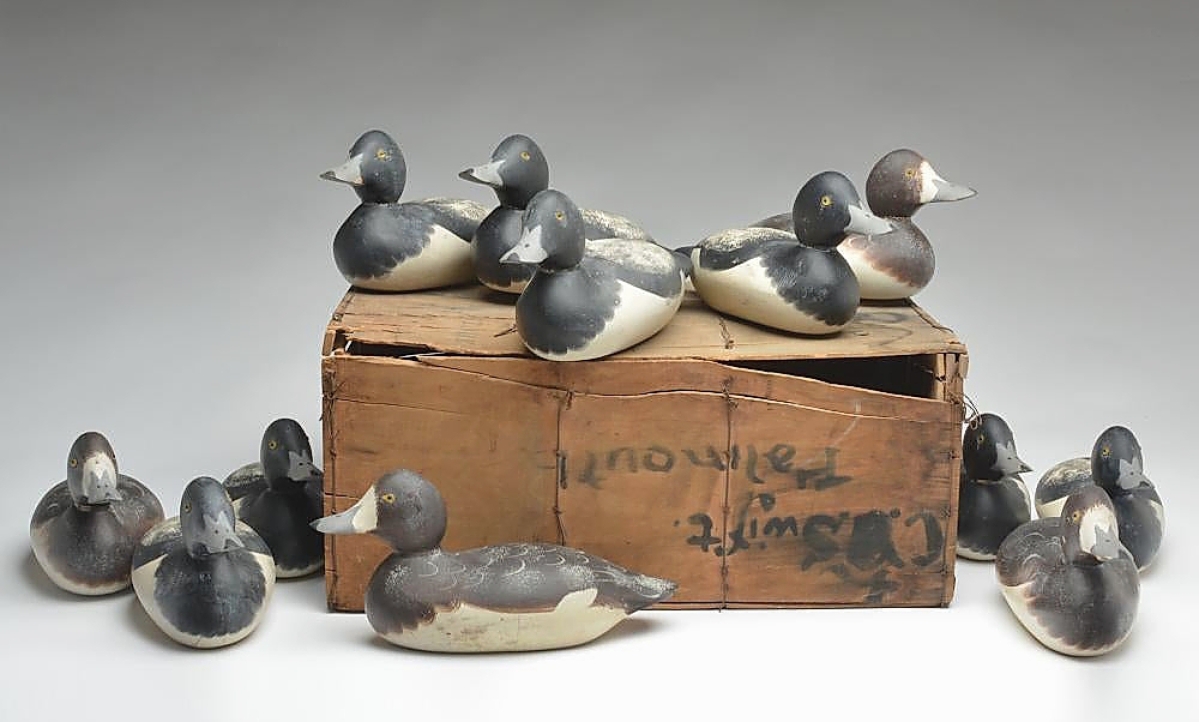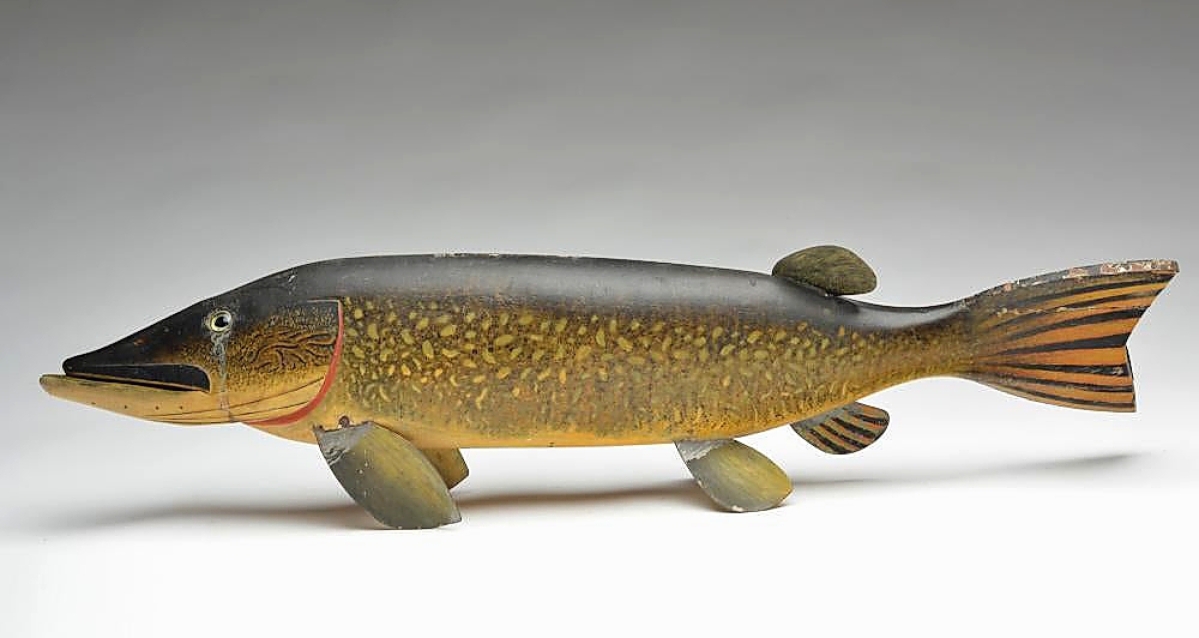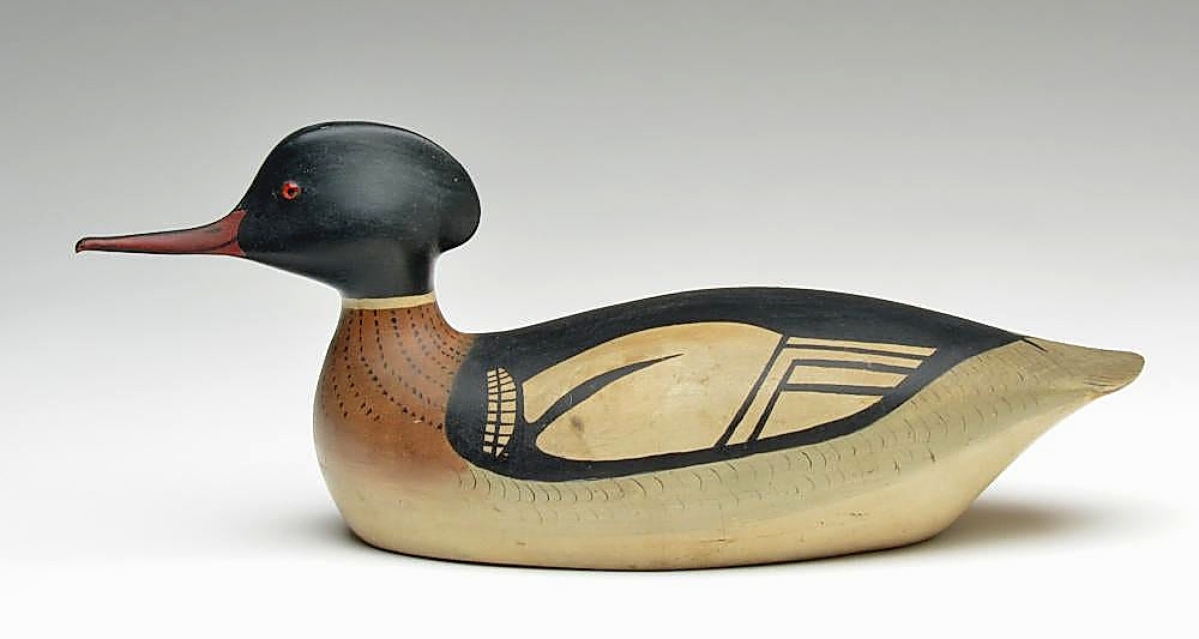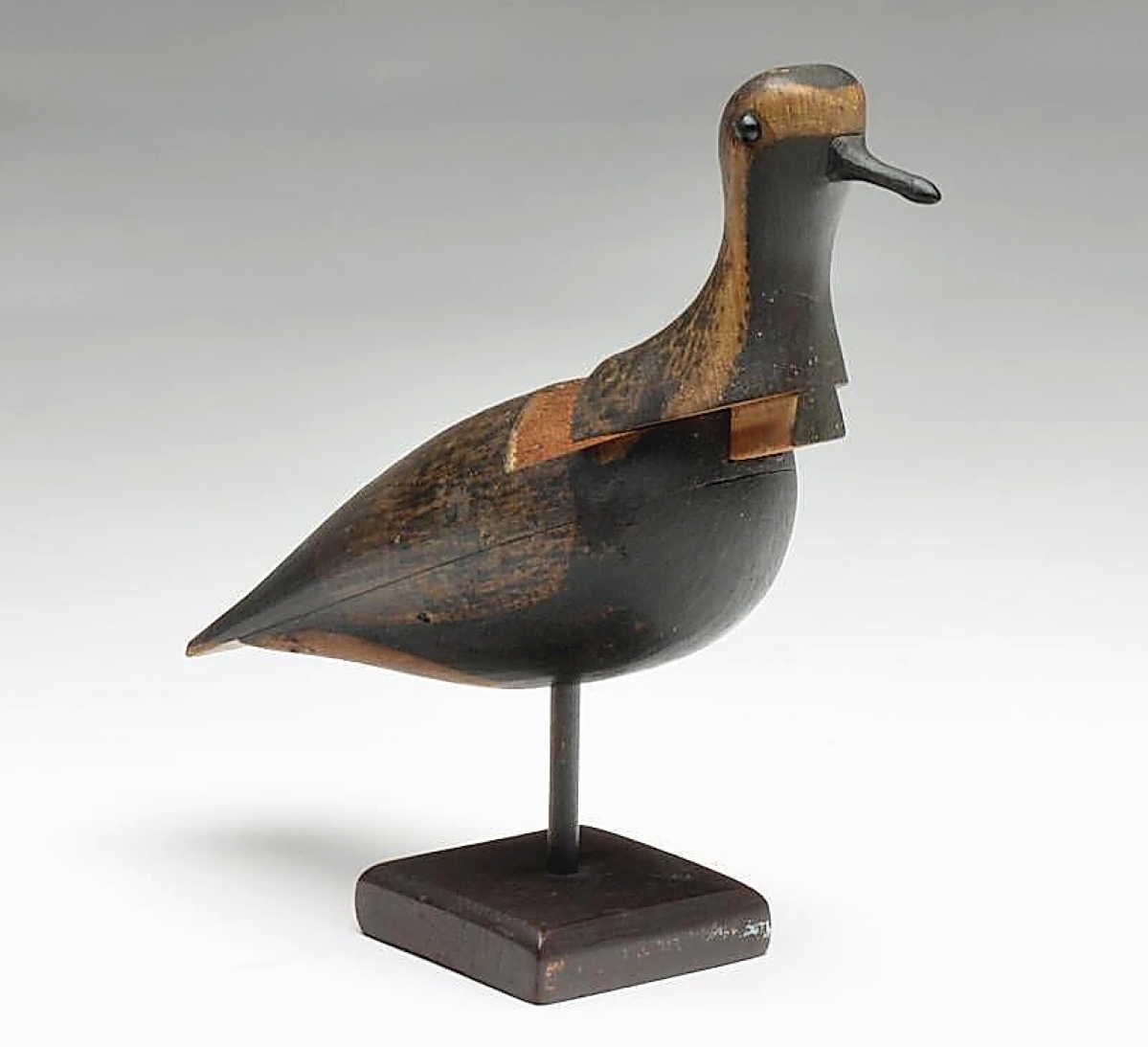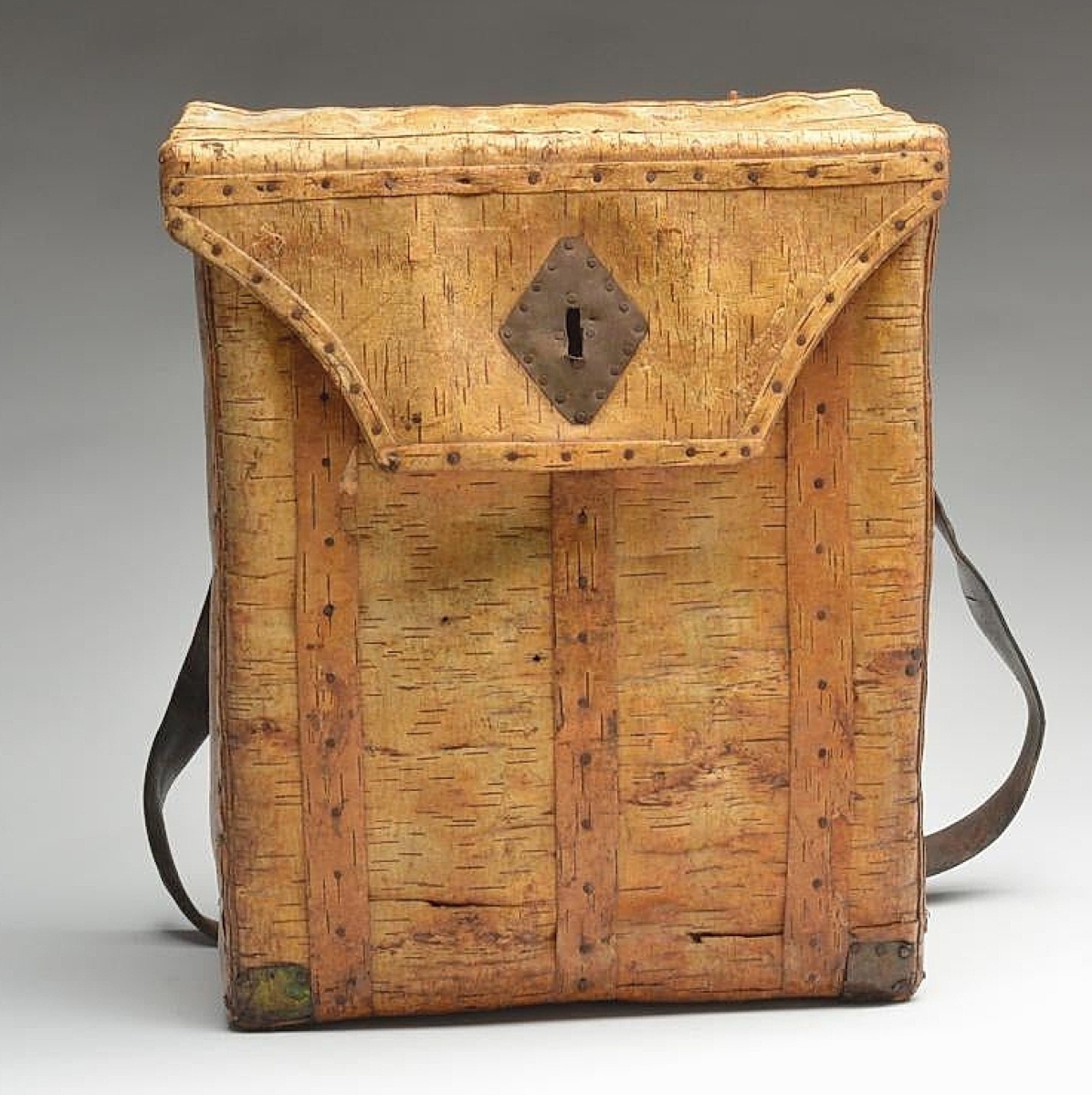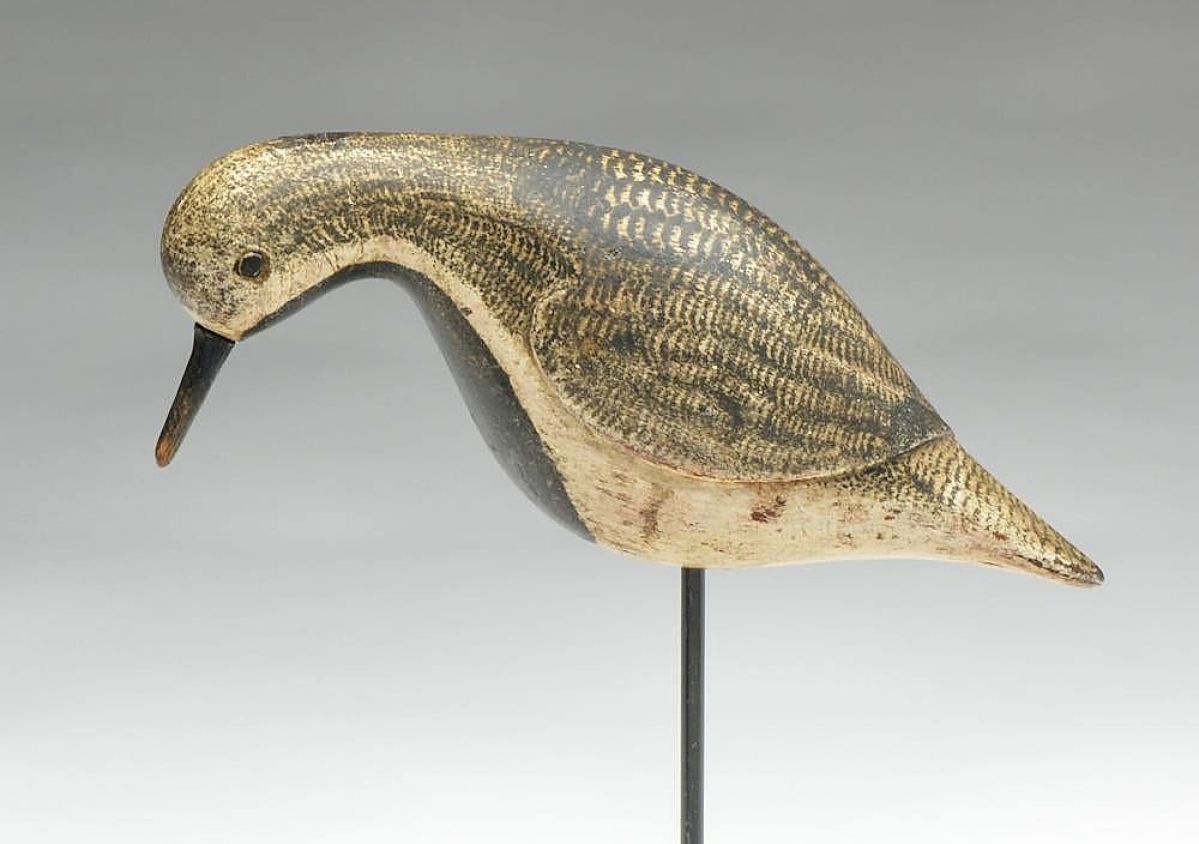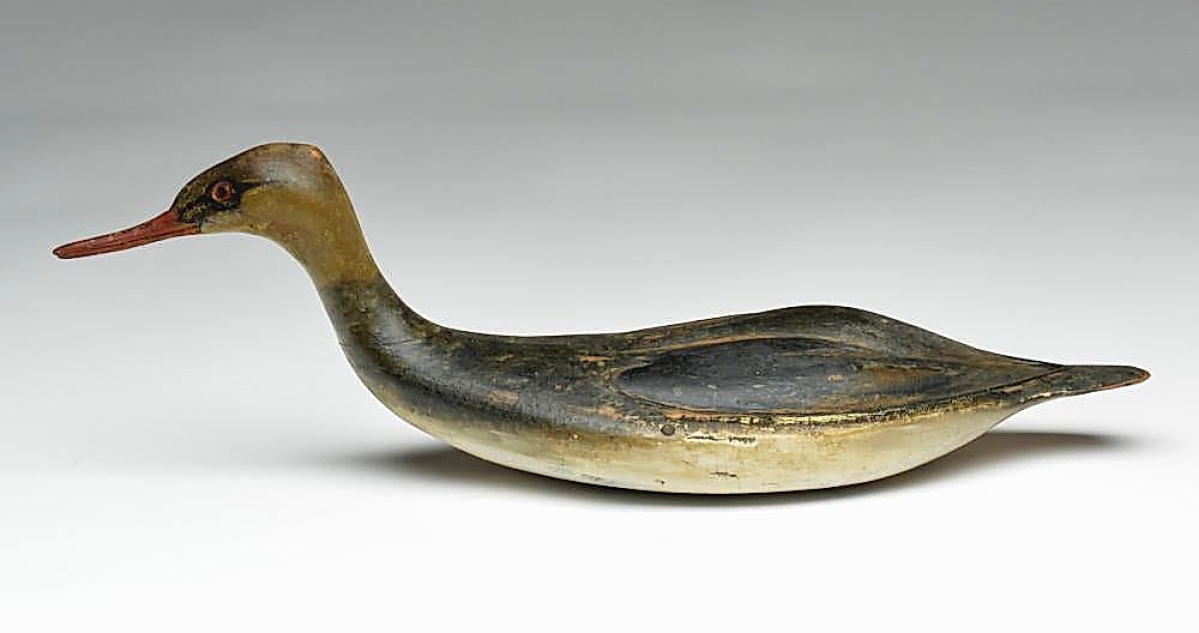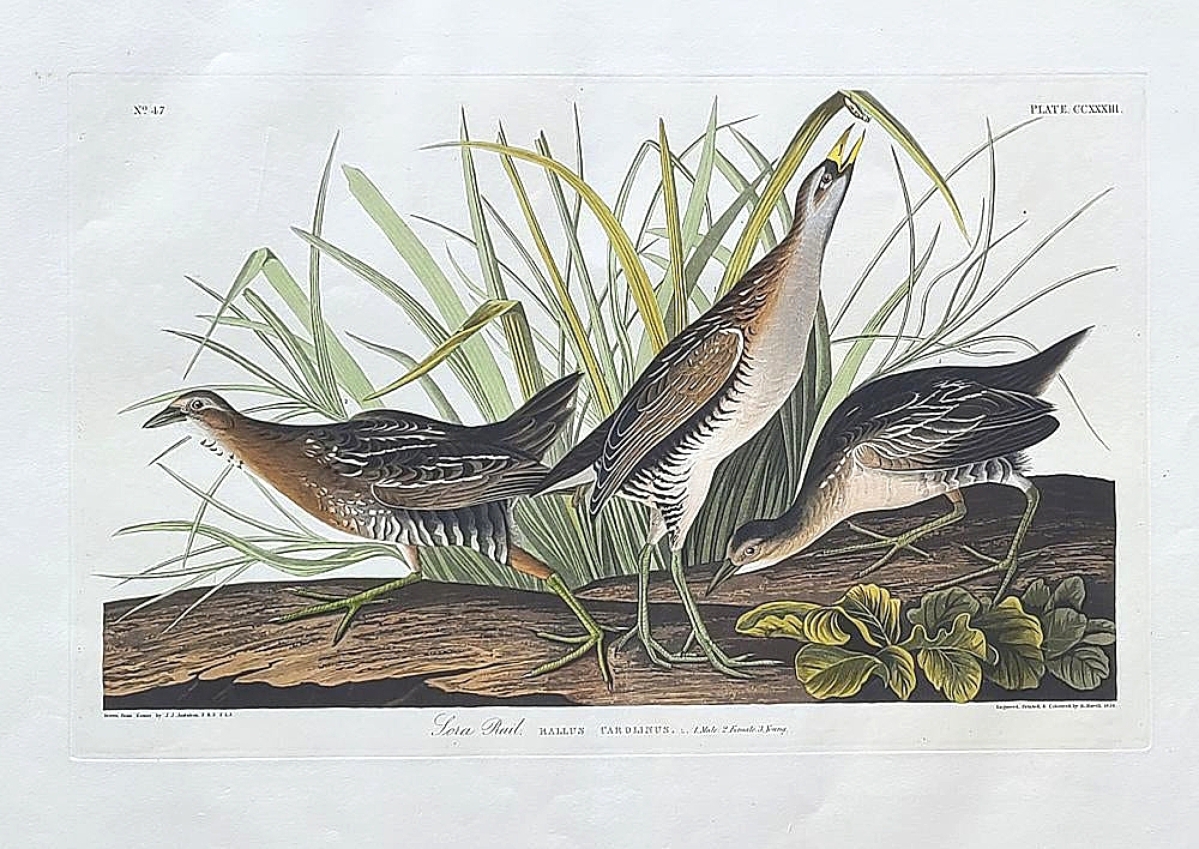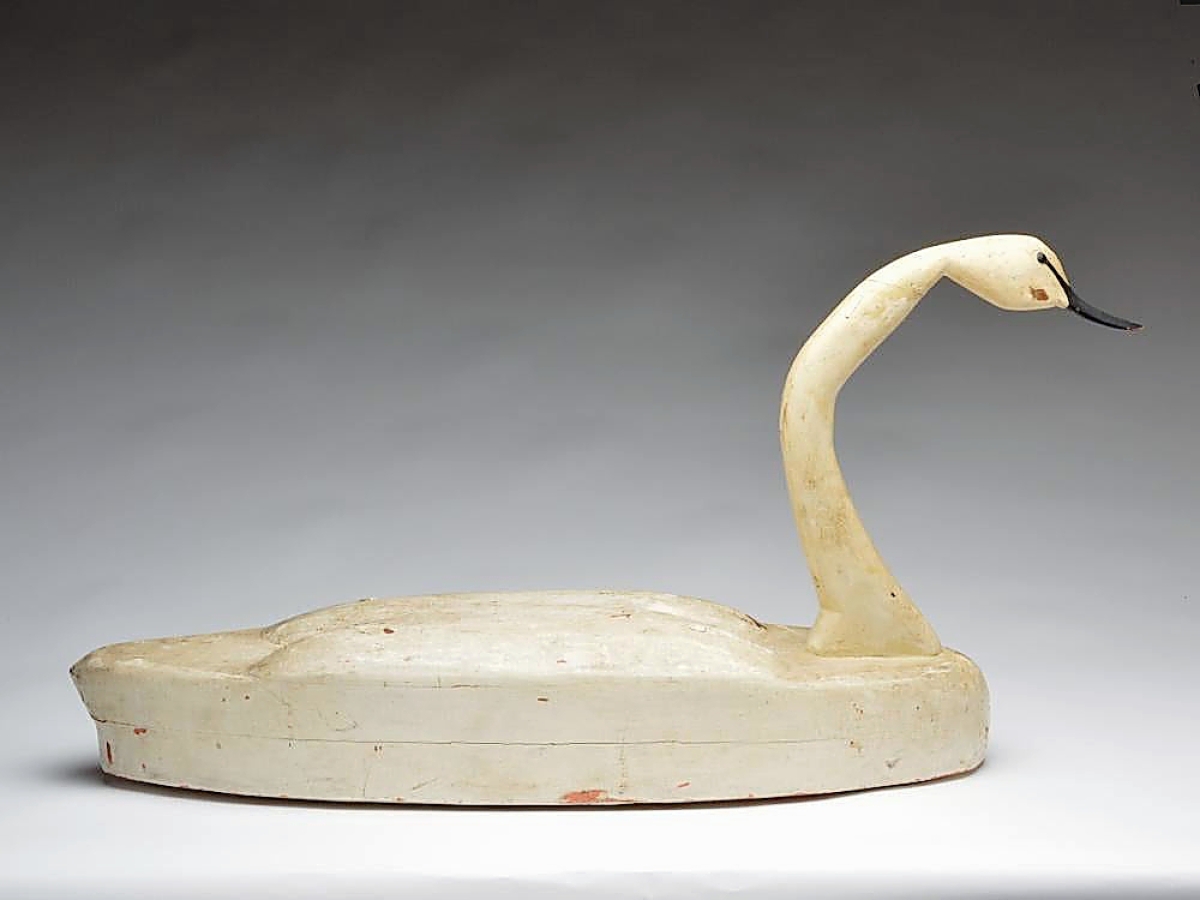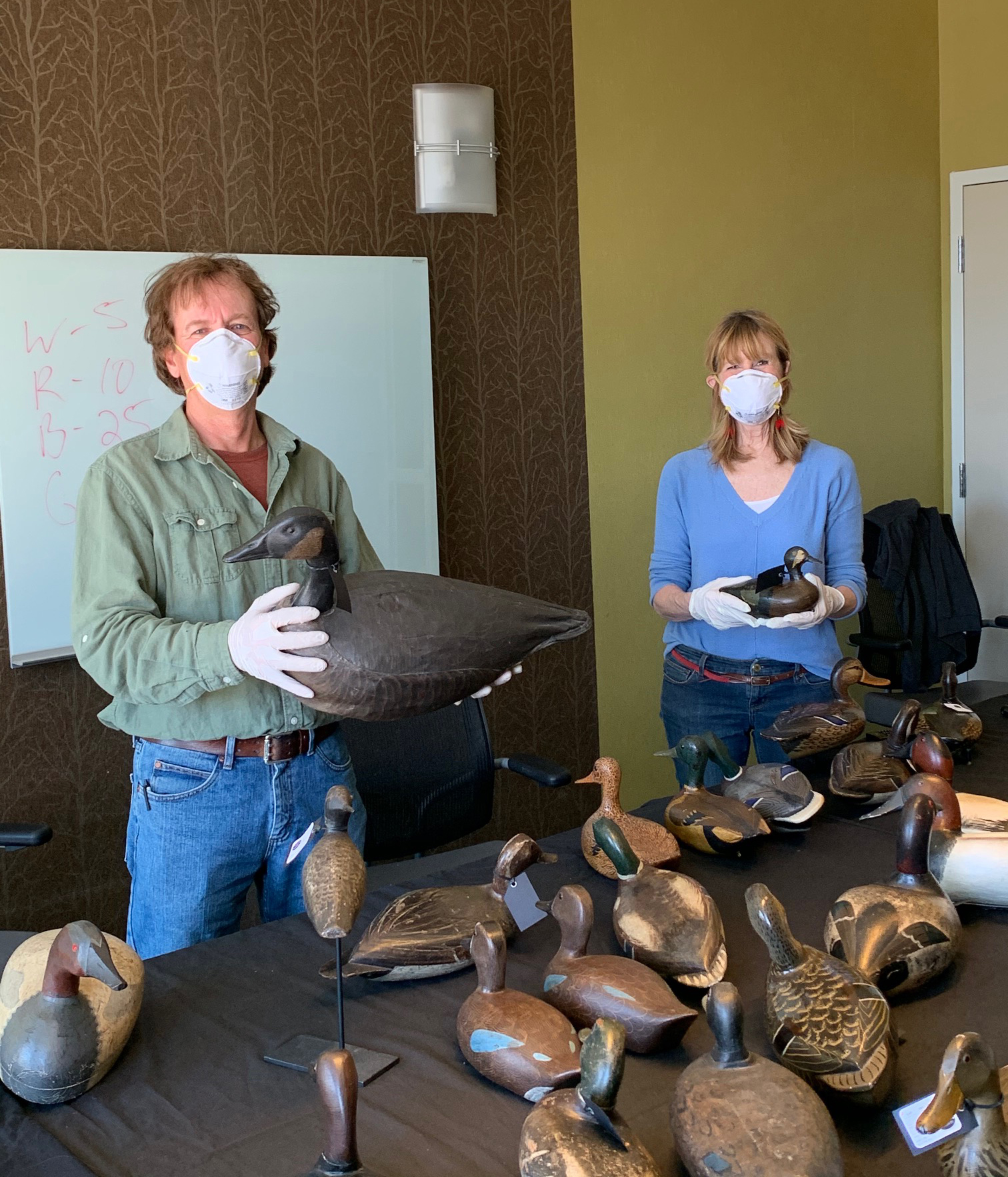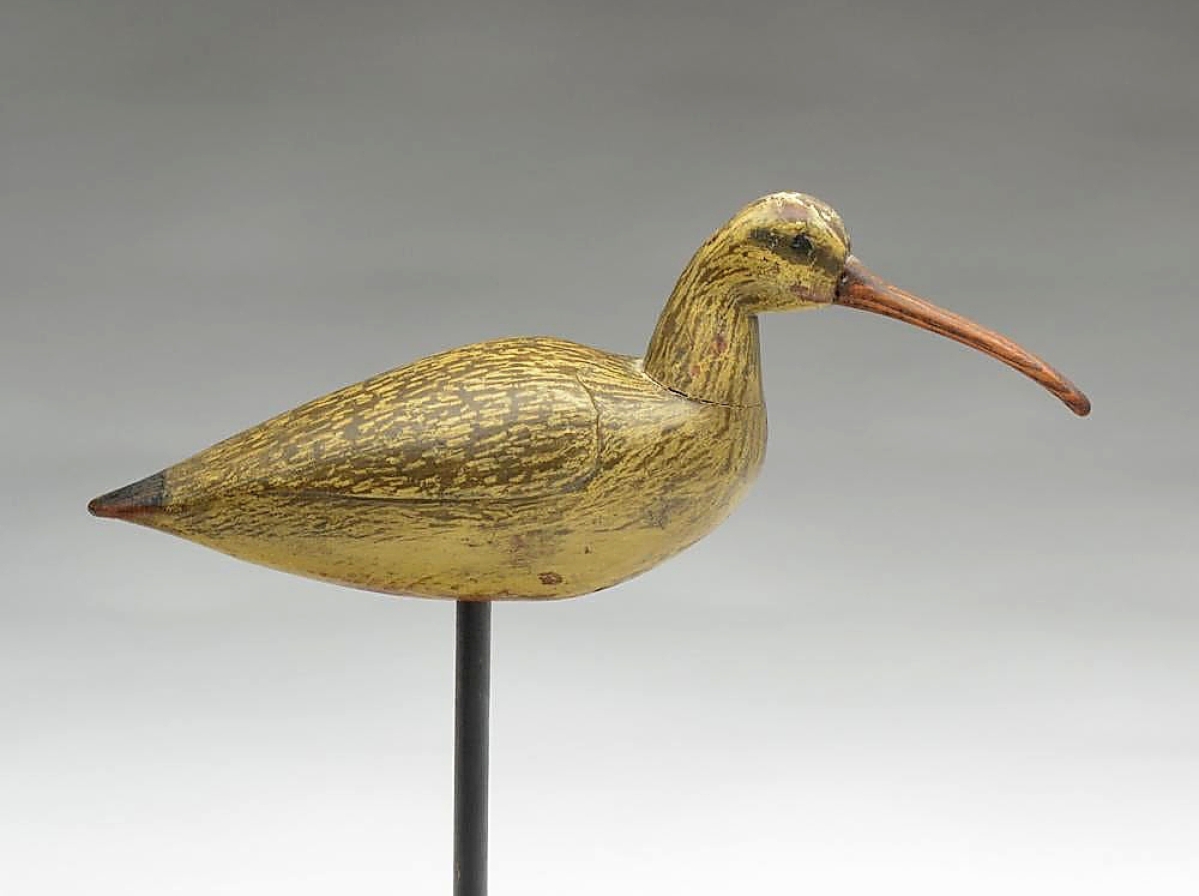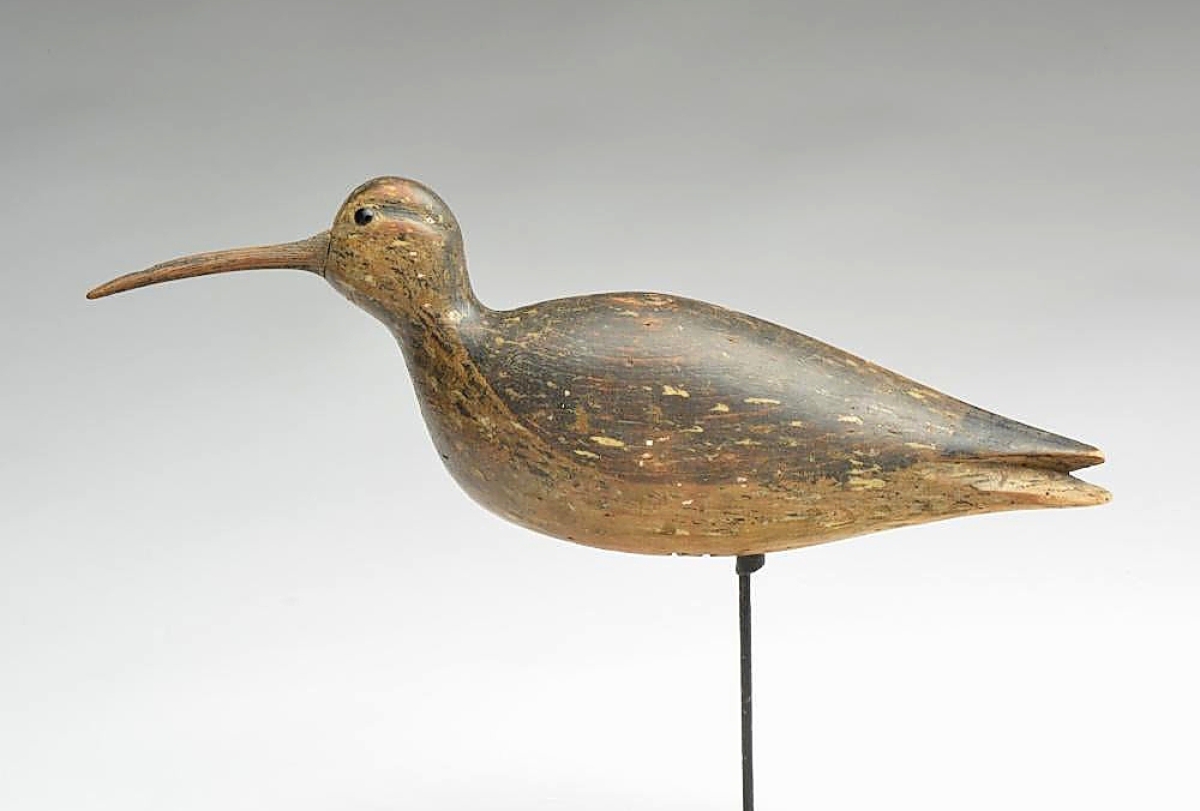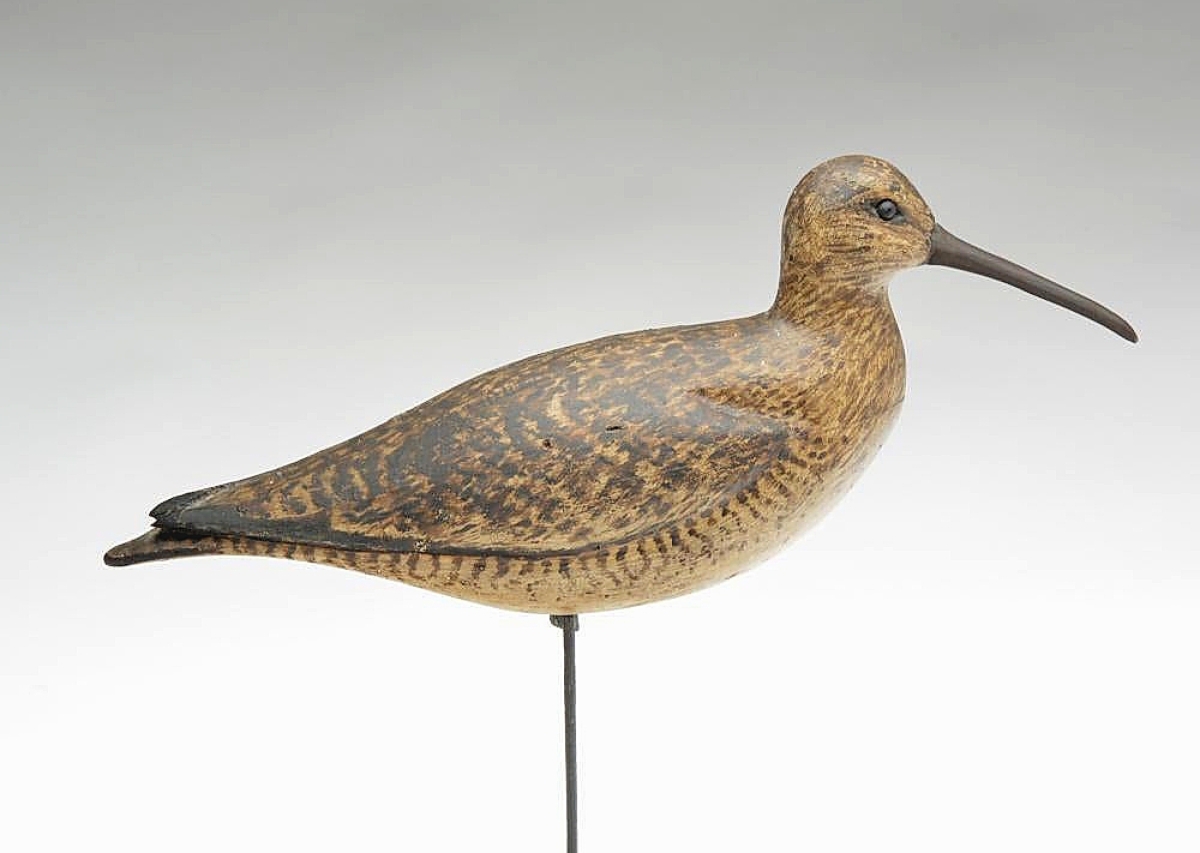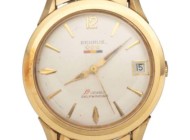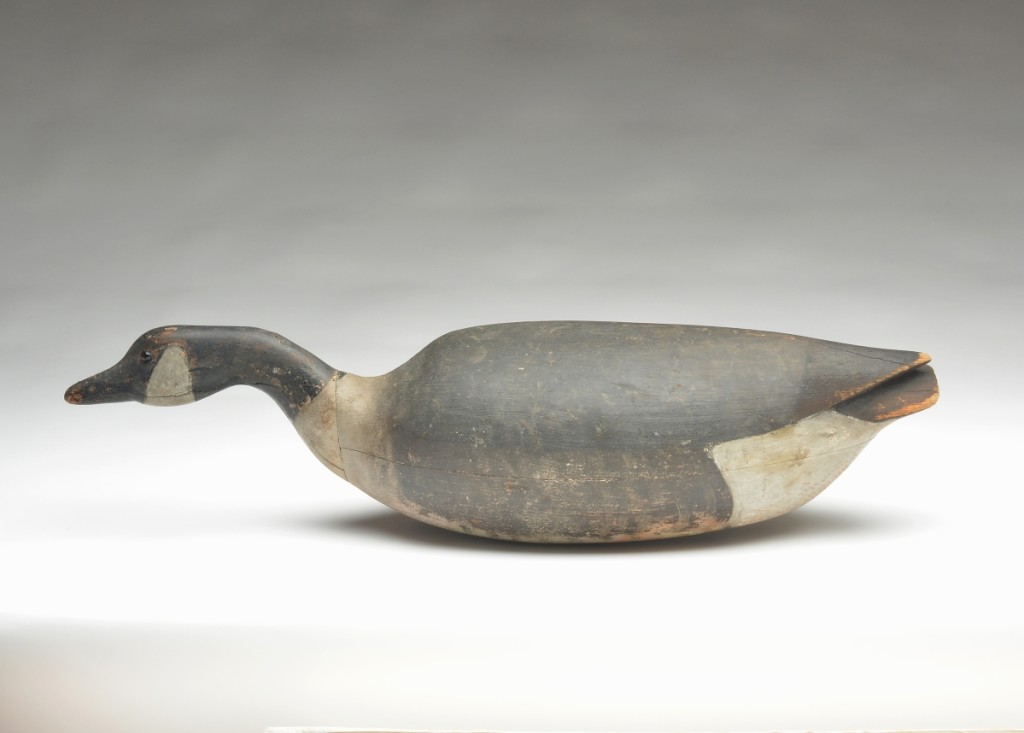
Nathan Cobb Jr’s hollow carved swimming Canada goose was the top priced lot in the sale, bringing $330,000. Other decoys from Cobb Island carvers were also sold and did well.
Review by Rick Russack, Photos Courtesy Guyette & Deeter
ST MICHAELS, MD – The Guyette & Deeter summer auction, usually conducted over a two-day period in Portsmouth, N.H., was conducted this year online with phone and absentee bidding available. Numerous rarities with A-list provenance were offered and topped by two Nathan Cobb Jr decoys that together brought more than $500,000. Eight decoys sold for more than $100,000, and more than 55 brought more than $10,000. The sale grossed $4 million. Jim Julia calls the Guyette & Deeter sales, and he’s still the same Jim Julia, a consummate entertainer. After the sale, commenting on the enthusiasm of the bidders and the number of new bidders, he said “If I were still an auctioneer, I’d love it. Everything is coming together perfectly.”
Much of the material offered in this sale came from the collection of the late Dr Lloyd Griffith, who had collected for more than 50 years with excellent taste and a desire to own the very best examples available in the marketplace. He regularly bought at the auctions of notable collectors like Dr James McCleery, William Mackey Jr and Dr George Starr. He did not hesitate to pay record-setting six-figure prices when the occasion called for it. The current marketplace validated his judgment.
The sale’s two top prices were realized by two decoys carved by Nathan Cobb Jr in the mid- to late Nineteenth Century on Cobb Island, Va. The island was home to the Cobb Island Hotel and the surrounding area provided extraordinary hunting opportunities for the wealthy sportsmen who spent time at the hotel. There were several talented carvers on the island and they developed a distinct and recognizable style of carving. Cobb is the recognized dean of the group, and his hollow carved swimming Canada goose was the top selling lot of the sale, finishing at $330,000. It had raised “V” wingtip carving, original paint and its provenance included the Mackey collection. It had been published frequently. Shorebird hunting was particularly popular on the island, and both ducks and shorebirds were often on the menu of the island’s hotel. Bringing the second highest price of the sale was a running curlew, which earned $210,000. It also had raised “V” wingtip carving and original paint with minor wear. Griffith had paid $390,000, a world auction record at the time, at the 2007 sale of the Mackey collection. Other Cobb Island decoys also did well.
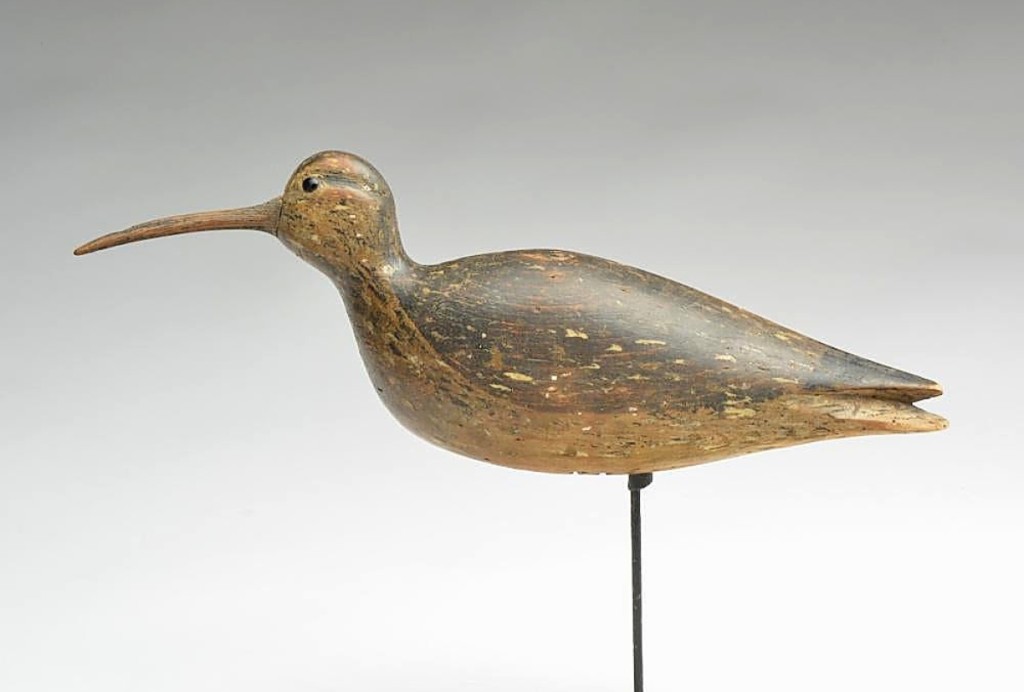
As with the Nathan Cobb Jr goose sold on the first day, the carver’s running curlew topped the second day, bringing $210,000. Again, the history of this decoy is well-known, and the catalog description of Cobb Island shore birds is extensive.
The second highest price of the first day of the sale, $168,000, was obtained by one of a group of exceptional shore birds by William Bowman, Lawrence, N.Y. It was a hollow carved long billed curlew dating to the late Nineteenth Century. It displayed fine wing carving with extended wing tips, minor repairs and the bill was a working replacement. Another of the group, selling for $84,000, was a willet, with the same carving details. It had come from the Mackey collection, where it was thought by Mackey to have been made by Elmer Crowell. The decoy appeared on the front cover of Decoy Hunter magazine in 1982, following its sale for a then world auction record price at a Richard Bourne auction. The companion of these two shorebirds was a greater yellowlegs in a content pose with relief carving and raised extended wingtips, which sold for $75,000. The total selling price of the three was $327,000. Recent research has questioned whether Bowman was the carver, or perhaps some birds, such as these three, were actually carved by Charles Sumner Bunn. The print catalog devotes a full page to this subject and the reasons for attributing these decoys to Bowman. Nine pages of the catalog, with numerous color photographs and text, are devoted to these three birds.
Decoys by prolific Cape Cod carver Elmer Crowell are always popular and this sale included a rare set of 25 miniature ducks, circa 1930. Over his long career, part of which time his son worked with him, Crowell produced working decoys, decorative life-size carvings, as well as miniatures. In addition to regular production, he would produce numerous carvings to special orders. The variety of species is wide and the carvings so life-like that many were used by schools for teaching ornithology. In addition to producing sets of ducks, Crowell also offered songbirds and shorebirds in sets of 25. Finding any complete set of 25 is extremely rare, and finding a set accompanied by Crowell’s original paperwork is rarer still. This set, according to the consignor, was purchased from Crowell around 1930 and has been displayed in a glass case ever since. According to Brian Cullity, author of a book on Crowell, a set such as this would have sold for $100 at that time. Sets of songbirds were less, and individual carvings sold between $2 and $15, depending on species and when they were made. This set of 25 with his business card and a list of the 25 on Crowell’s stationery sold for $108,000, more than twice its high estimate. Well more than a dozen of his miniatures were sold separately immediately following the set, and they sold between $960 and $13,000, depending on individual rarity. A rare life-size dowitcher reached $57,000. A full-size redhead drake, found in a boathouse in Florida and possibly never used, earned $28,800, and a black bellied plover sold for $13,200. There were many more.
Another rarity, possibly unique, was an unused group of 12 Mason Detroit grade bluebill decoys in their original factory shipping crate. Popular with collectors, there were several Mason decoys offered in various grades and condition. As expected, the crate of 12 was the most sought-after, finishing at $33,600. This is another instance where the auction catalog would be very helpful to an interested bidder. The online catalog entry is certainly descriptive and includes six photographs, plus a condition report. However, the printed catalog devotes a full four pages to this lot, including original research and relevant history, along with ten photographs. There were more than three dozen other Mason Factory decoys, including a rare red breasted merganser drake, which realized $27,600. Most Mason mergansers were American common mergansers. This decoy has been pictured in Mason Decoys by Russ Goldberger and Alan Haid, which has recently been updated to include their last 12 years of research on Mason, and the book also includes a chapter on Peterson and Dodge decoys. Both authors have been collecting since the 1970s.
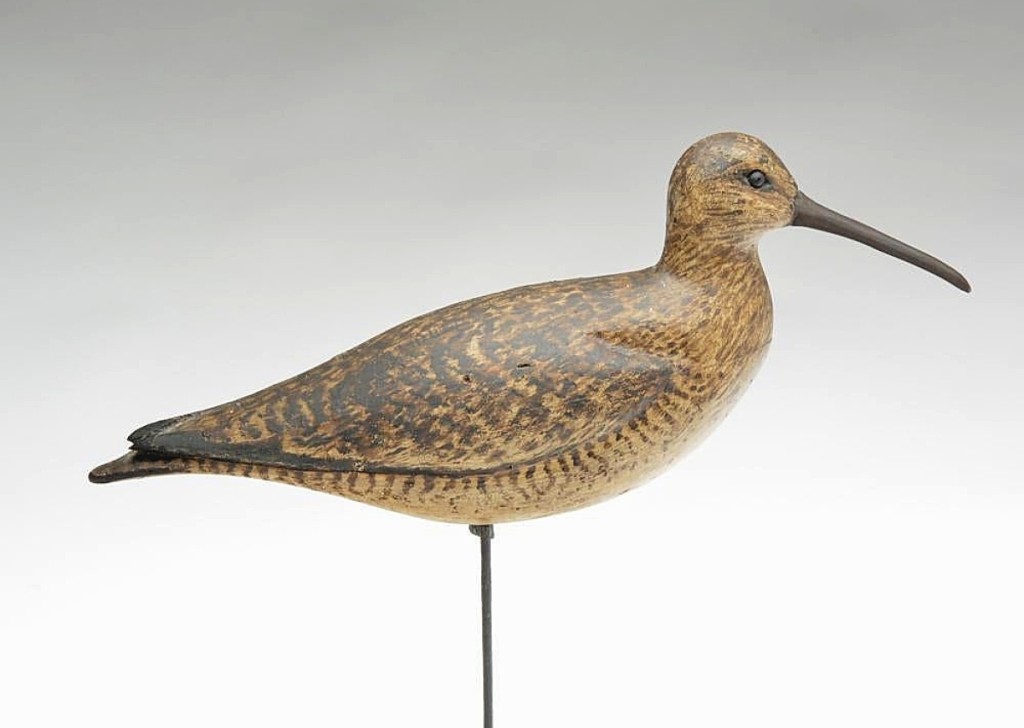
One of the highest prices of the sale was $168,000 paid for one of a group of three exceptional shore birds by William Bowman, Lawrence, N.Y. It was a hollow carved long billed curlew dating to the late Nineteenth Century. Its provenance is well-known, having been published and included in exhibitions.
The sale included more than just decoys. Arthur Fitzwilliam Tait (1891-1905) produced numerous outdoor and sporting scenes, many of which were reproduced by Currier & Ives, as well as Louis Prang. An oil by Tait depicting a very pleased looking water spaniel who has just retrieved a canvasback duck sold for $18,000. The sporting art category was topped by a Frank Stick (1884-1966) scene showing two mounted cowboys going after a retreating grizzly bear, which realized $23,400. The category included works by Edmund Osthaus (1858-1928) Ogden Pleissner (1905-1983) and others. There were Audubon prints, fish carvings, duck calls and more.
The online descriptions are thorough and include condition reports, but there is much more information in the 300-plus-page catalog the firm produced for the sale. Dozens of carvers are profiled in depth, often with previously unpublished information. Adding “color” to the descriptions are numerous vintage photos of carvers, early collectors, decoys in use, etc. Jon Deeter said that the work of gathering the information is a team effort involving the entire staff and after the sale added that they had received comments from collectors who said the additional information guided their bidding. Seasoned and newer collectors are bound to learn from the catalog. The company is unique in the decoy world in that catalog descriptions are fully guaranteed, something even rare in the broader field of selling antiques at auction. The company also offers a “trade-up” policy that allows for purchases to be paid for by consigning decoys from one’s collection. Deeter commented, “We really believe that our job isn’t just to sell decoys but to assist collectors with building the collection that they want. Both Gary [Guyette] and I have told collectors to skip bidding on certain decoys because they don’t really fit into the type of collection the buyer is aiming for.”
The company adapted to the COVID-19 restrictions, which eliminates a preview where all offerings can be handled and examined, in a unique way. The company took the decoys to the prospective buyers and the catalog said they would be willing to do that regardless of the value of the decoy. When Deeter was contacted a few days before the sale, he was asked about that service and how many decoys were shown that way. “We’ve all done a lot of traveling,” he replied. “How many have we shown? Yesterday I left here with 60 decoys to show prospective bidders in New York, New Jersey and Philadelphia. We’ve gone to New England, the Midwest and the South with these roadshows.”
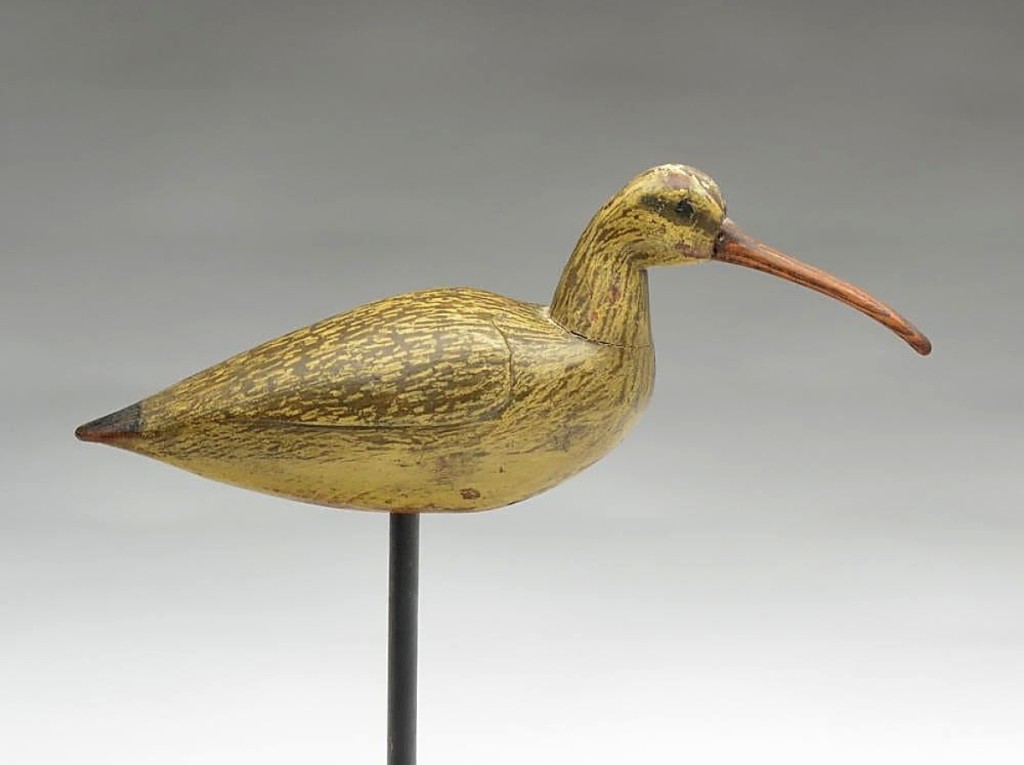
Luther Lee Nottingham was another of the carvers in the tradition of Cobbs Island. He worked in Cobbs Station and carved this curlew with a slightly turned head and relief carved wings. Its final price was $168,000.
Decoys are folk art, and several prominent folk art collectors and dealers have recognized that. Adele Earnest, Stewart Gregory, Electra Havemeyer Webb (founder of the Shelburne Museum), Nina Fletcher Little, along with many others, recognized decoys as folk art regardless of who made them. Not surprisingly, form, condition and surface affect value. But other factors influence value for today’s collector. While decoys were made and used all over the United States, and regional styles developed, recent research has shown that decoys representing certain birds were much less common in some areas because the ducks they were intended to attract are scarce in that area. Some ducks can easily be brought into a hunter’s range by seeing ducks of other species, though there may have been fewer decoys representing that species made. Shorebirds are what the name implies. If an inland carver made shorebirds, they’re probably rarer than decoys of ducks more common to the inland. Some carvers became known for a certain type of decoy because of the prevalence of the species in their region. For example, many carvers along the coast of Maine made eider decoys because there were many eiders along the coast. If one of those carvers made another type of decoy, it might be of special interest to collectors. And like any other field of collecting, there’s the subjective evaluation of good, better and best. How well done is the paint job? Are there extra flourishes, such as carved wing tips? And how much time did the carver take on that decoy on that day? Often carvers made decoys for special customers and devoted more time to those special orders.
After the sale, Deeter said, “We had a great collection to sell and, of course, we’re delighted with the results. In terms of dollars, the $4 million gross approached the upper range of our estimates. We had numerous first-time buyers, and I know some of the new buyers were strong underbidders. We went out of our way to make it possible for many collectors to see the birds before the sale, and we’ve had numerous positive comments on the catalog. We waived the percentage added on by the online platforms so as to not penalize collectors for not being able to attend a live sale. And we’ll be delivering to buyers whenever that’s feasible. So yes, Gary and I are pleased.”
Prices given include the buyer’s premium as stated by the auction house. For information, www.guyetteanddeeter.com or 410-745-0485.

